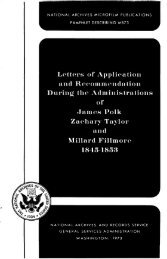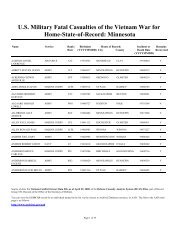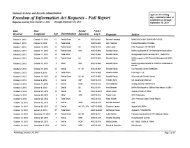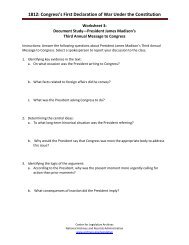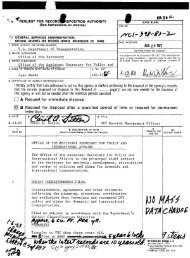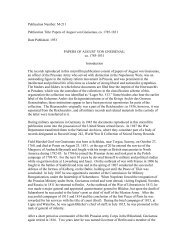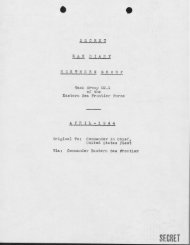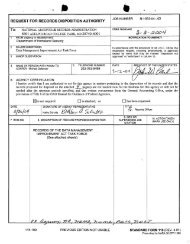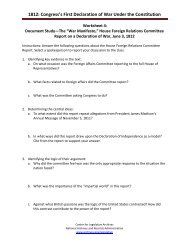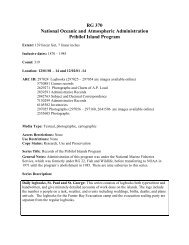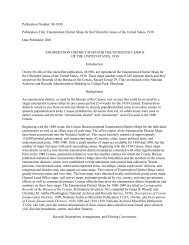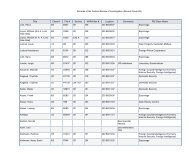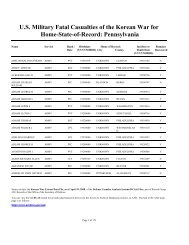NGSNews07July - National Archives and Records Administration
NGSNews07July - National Archives and Records Administration
NGSNews07July - National Archives and Records Administration
Create successful ePaper yourself
Turn your PDF publications into a flip-book with our unique Google optimized e-Paper software.
Canadian border immigration records,<br />
1895–1950s<br />
Part 1: The records<br />
national<br />
B Y CLAIRE PRECHTEL-KLUSKENS<br />
archives<br />
arrival.<br />
copy was kept at the INS office at<br />
The researcher seeking a pre- the alien’s port of entry <strong>and</strong> one<br />
1895 immigration record should copy was forwarded to the INS<br />
also check the 1895 <strong>and</strong> later im-<br />
District Office in Montreal, Que-<br />
Canada. The Montreal office<br />
migration records described below. bec,<br />
Aliens often departed from the U.S. was later moved to Saint Albans,<br />
<strong>and</strong> returned at a later date. An Vermont. The copies sent to the<br />
alien’s post-1895 arrival manifest INS District Office are included<br />
may therefore tell you the date <strong>and</strong> in NARA Microfilm Publication<br />
port of his previous arrival(s). M1464, Manifests of Passengers<br />
Arriving in the St. Albans, Vermont,<br />
1895–1950s<br />
District, through Canadian Pacifi c<br />
Underst<strong>and</strong>ing Canadian border <strong>and</strong> Atlantic Ports, 1895–1954.<br />
immigration records first requires The filing scheme became<br />
learning about the governmental more complicated on July 1917,<br />
administrative structure <strong>and</strong> pro- <strong>and</strong> changed again in July 1927<br />
cess that created them. The filing <strong>and</strong> July 1929. (In those days the<br />
scheme matters. Where was the re- federal fiscal year began on 1 July,<br />
cord created, where was that record so that is the reason for the July<br />
filed, <strong>and</strong> why?<br />
beginning dates. The federal fiscal<br />
<strong>Records</strong> of alien arrivals at the year now begins on 1 October.)<br />
U.S.-Canada border were created<br />
Eastern U.S.<br />
<strong>and</strong> collected by the Immigration<br />
From July 1917 to June 1929,<br />
<strong>and</strong> Naturalization Service (INS)<br />
alien arrivals at l<strong>and</strong> ports of entry<br />
<strong>and</strong> its predecessors, the Bureau<br />
in Maine westward to upstate<br />
of Immigration <strong>and</strong> Naturalization<br />
New York (along the St. Lawrence<br />
(1906–33) <strong>and</strong> the Superintendent<br />
River) were recorded in duplicate<br />
of Immigration (1891–1906).<br />
on the traditional “ship passenger<br />
From 1895 to June 1917,<br />
manifest.” One copy was kept at<br />
alien arrivals along the entire<br />
the port of entry <strong>and</strong> the other was<br />
U.S.-Canada border were re-<br />
sent to the INS District Office at<br />
corded in duplicate on the familiar<br />
Montreal <strong>and</strong> will be found in<br />
“ship passenger manifests.” One<br />
M1464.<br />
Did your ancestor immigrate<br />
to the United<br />
States by crossing the<br />
U.S.-Canada border? The U.S.<br />
government began keeping records<br />
of alien arrivals at the Canadian<br />
border in 1895. Part 1 of this article<br />
will introduce the U.S. records that<br />
document U.S.-Canada l<strong>and</strong> border<br />
crossings. In a future issue, part<br />
2 of this article will examine the<br />
interesting process by which those<br />
records were created <strong>and</strong> work<br />
through some case studies.<br />
Pre-1895 arrivals<br />
Researchers can document the<br />
date—or approximate date—of<br />
pre-1895 alien arrivals by using<br />
a variety of records. Federal cen-<br />
sus records for 1900, 1910, 1920,<br />
<strong>and</strong> 1930 ask each foreign-born<br />
person’s year of immigration to the<br />
U.S. An immigrant’s presence or<br />
absence in earlier censuses can help<br />
approximate the decade in which<br />
he arrived. Post-1906 naturalization<br />
records should include the date <strong>and</strong><br />
port of arrival, <strong>and</strong> pre-1906 often<br />
do so.<br />
Newspaper obituaries might<br />
mention the immigrant’s year of<br />
arrival. If he lived in a city after<br />
arrival in America, his sudden appearance<br />
in the annual city direc-<br />
tory could be a clue that he arrived<br />
in the U.S. a year or two before.<br />
Use clues from these <strong>and</strong> other records<br />
to narrow down that pre-1895<br />
NGS NewsMagazine · 43
Canadian border<br />
crossings microfilm<br />
publication chart<br />
As of June 2007<br />
Record Group 85, <strong>Records</strong> of the<br />
Immigration <strong>and</strong> Naturalization<br />
Service<br />
Number Title <strong>and</strong> Comments<br />
M1461 Soundex Index to Canadian<br />
Border Entries Through the<br />
St. Albans, Vermont, District,<br />
1895-1924. 399 rolls.<br />
Comment: There was no<br />
“St. Albans” District during<br />
these years. It is an index<br />
to all entries at Canadian<br />
seaports <strong>and</strong> through the<br />
Montreal District, which<br />
included the entire U.S.-<br />
Canada border through<br />
June 1917 <strong>and</strong> the entire<br />
U.S.-Canada border except<br />
Montana, Idaho, <strong>and</strong> Washington<br />
through June 1927.<br />
M1462 Alphabetical Index to<br />
Canadian Border Entries<br />
Through Small Ports in<br />
Vermont, 1895-1924. 6<br />
rolls. The ports of entry<br />
are Alburg, Beecher Falls,<br />
Canaan, Highgate Springs,<br />
Isl<strong>and</strong> Pond, Norton,<br />
Richford, St. Albans, <strong>and</strong><br />
Swanton.<br />
M1463 Soundex Index to Entries<br />
into the St. Albans, Vermont,<br />
District Through Canadian<br />
Pacific <strong>and</strong> Atlantic<br />
Ports, 1924-1952. 98 rolls.<br />
M1464 Manifests of Passengers<br />
Arriving in the St. Albans,<br />
Vermont, District, through<br />
Canadian Pacific <strong>and</strong> Atlantic<br />
Ports, 1895-1954. 639<br />
rolls. In addition to seaport<br />
arrivals, this index should<br />
include l<strong>and</strong> border entries<br />
from Maine to North<br />
Dakota for 1924-27, l<strong>and</strong><br />
border entries from Maine<br />
to New York for 1927-29,<br />
<strong>and</strong> l<strong>and</strong> border entries in<br />
From July 1917 to June 1927, From July 1927 to 1954 alien aralien<br />
arrivals at l<strong>and</strong> ports of entry rivals at these ports were recorded<br />
i n upstate New York (along the on card manifests <strong>and</strong> kept at the<br />
Great Lakes) westward through port of entry. Available microfilm<br />
North Dakota were recorded in publications are listed in the Cana-<br />
duplicate on the traditional “ship dian Border Crossings Microfilm<br />
p assenger manifest.” One copy was Publication Chart.<br />
kept at the port of entry <strong>and</strong> the<br />
other was sent to the INS District Who is in the<br />
Office at Montreal <strong>and</strong> will be records?<br />
found in M1464. From July 1927 From 1895 to late 1906, the<br />
to June 1929 alien arrivals at these records only include non-Canadi-<br />
ports were recorded in duplicate on ans entering the U.S. from Canada,<br />
card manifests. One copy was kept either permanent or in transit. “In<br />
at the port of entry <strong>and</strong> the other transit” means that the person was<br />
w as sent to the appropriate INS temporarily entering the U.S. for<br />
District Office at Buffalo, Detroit, business or pleasure <strong>and</strong> would<br />
o r Chicago. Available microfilm depart the U.S. at a different port.<br />
publications are listed in the Ca-<br />
border crossings microfilm records include both non-Canadian<br />
publication chart that accompanies <strong>and</strong> Canadian citizens. A “Canadi-<br />
this article.<br />
an citizen” could be someone who<br />
From July 1929 to 1954, alien was born in Canada or someone<br />
From late 1906 to the 1950s, the<br />
nadian<br />
arrivals at l<strong>and</strong> ports of entry in who became a Canadian citizen<br />
Maine westward through North Da-<br />
were recorded on card mani-<br />
Some U.S. citizens are also found<br />
fests <strong>and</strong> kept at the port of entry. in the records. Typically these<br />
through the naturalization process.<br />
kota<br />
Available mi-<br />
publica-<br />
crofilm<br />
tions are listed<br />
in the Canadian<br />
Border Cross-<br />
Microfilm<br />
ings<br />
Publication<br />
Chart.<br />
Far Western<br />
U.S.<br />
From July<br />
1917 to June<br />
1927, alien<br />
arrivals at l<strong>and</strong> Front of Paul Lyman Roberts card.<br />
ports of entry in<br />
Montana, Idaho, <strong>and</strong> Washington persons had either been absent<br />
were recorded in duplicate on the from the U.S. for a long period of<br />
traditional “ship passenger maniest.”<br />
One copy was kept at the port permanently.<br />
time or who were leaving the U.S.<br />
f<br />
of entry <strong>and</strong> the other was sent to Let’s take a look at a few<br />
the INS District Office at Seattle. interesting records to see what we<br />
44 · July–September 2007
can find. Let’s start with <strong>National</strong><br />
<strong>Archives</strong> Microfilm Publication<br />
A3440, Manifests of Alien Arrivals<br />
at Sweet Grass, Montana, August<br />
1917–June 1954, roll 15. Here is<br />
Paul Lyman Roberts on an INS<br />
Form 548 card manifest that tells<br />
us he was born 16 January 1885 at<br />
Monroe County, Michigan, <strong>and</strong> had<br />
lived in the U.S. from his birth until<br />
1910. He was a Canadian citizen,<br />
a rancher, living in Bengough,<br />
Saskatchewan. He had been in the<br />
U.S. several times since 1910, the<br />
last time being<br />
in November<br />
1939. This<br />
manifest was<br />
dated 11 December<br />
1939.<br />
He planned to<br />
visit the U.S.<br />
for six months.<br />
His destination<br />
was his son,<br />
Clair Roberts,<br />
16005 Bassit<br />
[sic] Street,<br />
Van Nyes [sic],<br />
California. He was bringing $965<br />
with him. Perhaps because he had<br />
such a large sum of money on him,<br />
the immigration inspector noted<br />
the amount of l<strong>and</strong> (1/2 section)<br />
<strong>and</strong> money in the bank (more than<br />
$19,000) back home as evidence of<br />
this man’s temporary arrival.<br />
Now let’s turn to<br />
<strong>National</strong> <strong>Archives</strong><br />
Microfilm Publication<br />
A3441, Manifests of<br />
Alien Arrivals at Port<br />
Huron, Michigan, February<br />
1902–December<br />
1954, Roll 27. Here is<br />
Rebecca Dennison on<br />
INS Form 657 Record of<br />
Registry. She originally<br />
entered the U.S. at Port<br />
Front of Rebecca Dennison’s card.<br />
Huron, Michigan on 5 December<br />
1919, when she was 24 years, 10<br />
months old. In 1919, she had lived<br />
in Hamilton, Ontario. A record of<br />
her arrival should have been made<br />
in 1919, but the INS could not find<br />
one, so this Record of Registry was<br />
created on 28 April 1931 as an<br />
after-the-fact record of her 1919 arrival.<br />
In 1931, she was 36 years, 5<br />
months old, <strong>and</strong> lived at 915 Fourth<br />
Street, Peoria, Illinois. Her physical<br />
description (eye color, hair color,<br />
<strong>and</strong> height) is given along with<br />
her photograph. She was born in<br />
Zitomir, Wolinsky, Russia.<br />
Julia Evangeline Denomme is<br />
also found in A3441, Roll 27, on<br />
INS Form I-189, Application for<br />
Resident Alien’s Border Crossing<br />
Identifi cation Card. Bad typing<br />
makes her surname nearly illegible<br />
Back of Julia Evangeline Denomme’s card.<br />
A3386<br />
A3400<br />
A3401<br />
A3402<br />
A3403<br />
A3416<br />
A3428<br />
A3429<br />
A3434<br />
Vermont only for 1929-54.<br />
Manifests of Alien <strong>and</strong><br />
Citizen Arrivals at Babb,<br />
Montana, June 1928-October<br />
1956. 3 rolls. More than<br />
16,000 manifests.<br />
Manifests of Alien Arrivals<br />
at International Falls,<br />
Baudette, Duluth, Mineral<br />
Center, Pigeon River, Pine<br />
Creek, Roseau, <strong>and</strong> Warroad,<br />
Minnesota, January<br />
1907-December 1952. 2<br />
rolls. More than 15,000<br />
manifests.<br />
Manifests of Alien Arrivals<br />
at Eastport, Fort Kent,<br />
Lubec, <strong>and</strong> Madawaska,<br />
Maine, ca. 1906-December<br />
1952. 2 rolls.<br />
Manifests of Alien Arrivals<br />
at Newport, Vermont, ca.<br />
1906-June 1924. 8 rolls.<br />
More than 60,000 manifests.<br />
Manifests of Alien <strong>and</strong><br />
Selected U.S. Citizen Arrivals<br />
at Anacortes, Danville,<br />
Ferry, Laurier, Lynden,<br />
Marcus, Metaline Falls,<br />
Northport, Oroville, Port<br />
Angeles, <strong>and</strong> Sumas, Washington,<br />
May 1917-November<br />
1956. 14 rolls. More<br />
than 75,000 manifests.<br />
Manifests of Alien Arrivals<br />
at Portal, North Dakota,<br />
1915-1921. 4 rolls. More<br />
than 13,000 manifests.<br />
Manifests of Alien Arrivals<br />
at Bangor <strong>and</strong> Houlton,<br />
Maine, ca. 1906-1953. 3<br />
rolls. More than 20,000<br />
manifests.<br />
Manifests of Alien Arrivals<br />
at Algonac, Marine City,<br />
Roberts L<strong>and</strong>ing, Saint<br />
Clair, <strong>and</strong> Sault Sainte Marie,<br />
Michigan, 1903-1955.<br />
8 rolls. More than 59,000<br />
manifests.<br />
Indexes <strong>and</strong> Manifests of<br />
Alien Arrivals at Anchorage,<br />
Juneau, Skagway, <strong>and</strong><br />
Tok Junction, Alaska, ca.<br />
1910-ca. 1956. More than<br />
NGS NewsMagazine · 45
A3440<br />
A3441<br />
A3445<br />
A3447<br />
A3448<br />
M1365<br />
M1478<br />
M1480<br />
M1481<br />
2,200 records.<br />
Manifests of Alien Arrivals<br />
at Sweet Grass, Montana,<br />
August 1917-June 1954. 18<br />
rolls. More than 106,000<br />
manifests.<br />
Manifests of Alien Arrivals<br />
at Port Huron, Michigan,<br />
February 1902-December<br />
1954. 41 rolls. More than<br />
225,000 alien arrivals.<br />
L<strong>and</strong> Border Entries <strong>and</strong><br />
Passenger Lists of Vessels<br />
Arriving at Vancouver <strong>and</strong><br />
Victoria, British Columbia,<br />
Canada, January 1894-February<br />
1905. 7 rolls.<br />
Manifests of Alien Arrivals<br />
at Chief Mountain, Cut<br />
Bank, Del Bonita, Gateway,<br />
Great Falls, <strong>and</strong> Roosville,<br />
Montana, 1923-1956, <strong>and</strong><br />
of Alien Departures from<br />
Great Falls, Montana,<br />
1944-1945. 5 rolls. More<br />
than 17,000 manifests.<br />
Manifests of Alien Arrivals<br />
at Havre, Loring, Opheim,<br />
Raymond, Turner, Westby,<br />
<strong>and</strong> White Tail, Montana,<br />
1924-1956. 10 rolls. More<br />
than 50,000 manifests.<br />
Certificates of Head Tax<br />
Paid by Aliens Arriving<br />
at Seattle from Foreign<br />
Contiguous Territory, 1917-<br />
1924. 10 rolls.<br />
Card Manifests (Alphabetical)<br />
of Individuals Entering<br />
Through the Port of Detroit,<br />
Michigan, 1906-1954. 117<br />
rolls.<br />
Manifests of Alien Arrivals<br />
at Buffalo, Lewiston, Niagara<br />
Falls, <strong>and</strong> Rochester,<br />
New York, 1902-1954. 165<br />
rolls. More than 1,000,000<br />
manifests. These records<br />
were described in Claire<br />
Prechtel-Kluskens, “One<br />
Million More 1902-1954<br />
Immigration <strong>Records</strong> are<br />
Now Available!” NGS<br />
NewsMagazine 29 (March/<br />
April 2003): 58-59.<br />
Alphabetical Card Maniat<br />
the top of<br />
the card, but<br />
her signature<br />
on the reverse<br />
side is clear,<br />
<strong>and</strong> her name<br />
is clear on a<br />
1941 manifest<br />
that follows<br />
as the very<br />
next card on<br />
the microfilm.<br />
From<br />
the I-189,<br />
we learn that<br />
she resides at<br />
29416 Legion<br />
Street,<br />
Roseville,<br />
Michigan.<br />
She was born<br />
11 December<br />
1909 at<br />
Front <strong>and</strong> back of Benjamin Bosworth Haight’s card.<br />
Zurich, Ontario. She had entered the U.S. on 16 June 1929 by ferry boat<br />
under the name Julia Evangeline Ducharme. Her physical description is<br />
given. She applied for the border crossing card on 19 December 1951.<br />
Being an alien, she had registered with the INS as required by law, <strong>and</strong><br />
her alien registration number is noted on the card.<br />
Benjamin Bosworth Haight is found in A3441, Roll 12. He was<br />
recorded on 7 November 1916 on INS Form Spl. 187, Primary Inspection<br />
Memor<strong>and</strong>um. He’s another example of a U.S.-born Canadian citizen<br />
returning “home.” This record shows that he was age 75, married, <strong>and</strong> a<br />
Canadian citizen of Welsh descent. He was born in Macedon, New York,<br />
<strong>and</strong> had lived in the U.S. from 1841 (birth year) until 1852. Benjamin’s<br />
sister, Venilla Schooley, remained in Canada, but he was going to Clifford,<br />
Michigan, where his brother Samuel E. Haight lived.<br />
These four examples may not be typical but they certainly illustrate<br />
the potential that exists in these records for finding useful information<br />
about your family.<br />
Types of card manifests created<br />
The traditional ship passenger list form made sense for recording<br />
passengers arriving on a steamship, but a huge list was unwieldy when<br />
recording individuals or families coming by foot, train, or car. Individual<br />
card manifests were easier to h<strong>and</strong>le, <strong>and</strong> could be alphabetically arranged<br />
to make it easier to locate an individual’s arrival record at some<br />
later date for official purposes, such as verification of entry for naturalization<br />
applications. Naturally, different forms were used for different<br />
purposes. Some of the most common forms are described below.<br />
46 · July–September 2007
INS Form 548, 548-B, or I-448, Manifest or Report of Inspection,<br />
generally includes the person’s name, age, gender, marital status, place<br />
of birth, physical description, occupation, citizenship (nationality), race,<br />
ability to read <strong>and</strong> write <strong>and</strong> in what language, place of last permanent<br />
residence, port <strong>and</strong> date of arrival, destination, purpose for entering the<br />
U.S., intention of becoming a U.S. citizen or of returning to country of<br />
previous residence, head tax status, <strong>and</strong> previous citizenships. It also<br />
includes the name <strong>and</strong> address of the friend or relative whom the alien intended<br />
to join, persons accompanying the alien, <strong>and</strong> the name <strong>and</strong> address<br />
of the alien’s nearest relative or friend in the country from which he or<br />
she came. If the alien had ever been in the U.S. in the past, the dates <strong>and</strong><br />
places of such residence or visitation are indicated. Additional information<br />
may be recorded if the alien appealed a decision deporting or barring<br />
him or her from entering the United States. Form 548-B was used for INS<br />
records indexing projects by employees of the Works Progress <strong>Administration</strong><br />
(WPA) during the 1930s.<br />
INS Form 521, a pre-entry examination form, includes the person’s<br />
name, gender, age, place of birth, country of citizenship, home address,<br />
<strong>and</strong> the names of any accompanying children under age 16. For aliens,<br />
the person’s occupation, destination in the U.S., the name of the person<br />
to whom he was destined, <strong>and</strong> the intended length of stay in the U.S.<br />
were also recorded. The reverse side of the card states, in part, that “This<br />
form is intended to facilitate the entry into the United States of returning<br />
United States citizens, aliens lawfully resident in the United States returning<br />
from a temporary visit to Canada, <strong>and</strong> aliens coming from Canada<br />
for a temporary visit. It should be filled out, signed, <strong>and</strong> presented to a<br />
United States immigration officer at Halifax, Yarmouth, St. John (New<br />
Brunswick), Quebec, Montreal, Winnipeg, Vancouver, Victory, or Sidney<br />
(British Columbia).”<br />
INS Form 657, Record of Registry, includes the following information<br />
about the alien as of the alien’s date of arrival: name; age; occupation;<br />
race or people; place of last residence before entry; <strong>and</strong> date, port, place,<br />
<strong>and</strong> means (ship, railway, or other) of arrival in the U.S. This form also<br />
includes the following information about the alien as of the alien’s date of<br />
registry: name, age, occupation, physical description, place of residence,<br />
<strong>and</strong> place of birth. It also includes the alien’s photograph, date of approval<br />
of registry, certificate of registry number, district file number, <strong>and</strong> bureau<br />
(registry) file number.<br />
INS Form 694, Record of Alien Admitted as Visitor, includes the<br />
person’s name, home address, date <strong>and</strong> place of birth, gender, marital<br />
status, occupation, citizenship (nationality), race, color of hair <strong>and</strong> eyes,<br />
height, names <strong>and</strong> ages of accompanying children under age sixteen,<br />
home address <strong>and</strong> nearest relative there, destination, length of time admitted,<br />
signature, <strong>and</strong> date <strong>and</strong> place of admission to the U.S. The reverse<br />
side indicates the date <strong>and</strong> port of departure.<br />
INS Form I-94, I-94B, I-94(C), I-94(E), I-94F, or 257D, Record of<br />
Alien Admitted for Temporary Stay, includes the alien’s name, date <strong>and</strong><br />
place of birth, gender, marital status, occupation, citizenship (nationality),<br />
physical description, names of accompanying alien children under age 14,<br />
M1482<br />
M2016<br />
M2017<br />
M2018<br />
M2042<br />
M2046<br />
M2064<br />
M2065<br />
M2071<br />
fests of Alien Arrivals at<br />
Alex<strong>and</strong>ria Bay, Cape Vincent,<br />
Champlain, Clayton,<br />
Fort Covington, Mooers,<br />
Rouses Point, Thous<strong>and</strong><br />
Isl<strong>and</strong> Bridge, <strong>and</strong> Trout<br />
River, New York, July<br />
1929-April 1956. 3 rolls.<br />
More than 22,000 manifests.<br />
Soundex Card Manifests of<br />
Alien <strong>and</strong> Citizen Arrivals<br />
at Hogansburg, Malone,<br />
Morristown, Ny<strong>and</strong>o, Ogdensburg,<br />
Rooseveltown,<br />
<strong>and</strong> Waddington, New York,<br />
July 1929-April 1956. 3<br />
rolls. More than 19,000<br />
manifests.<br />
Alphabetical Index of<br />
Alien Arrivals at Eagle,<br />
Hyder, Ketchikan, Nome,<br />
<strong>and</strong> Skagway, Alaska, June<br />
1906-August 1946. 1 roll.<br />
Lists of Aliens Arriving<br />
at Skagway (White Pass),<br />
Alaska, October 1906-November<br />
1934. 1 roll.<br />
Lists of Aliens Arriving at<br />
Eagle, Alaska, December<br />
1910-October 1938. 1 roll.<br />
Alphabetical Manifest<br />
Cards of Alien Arrivals at<br />
Calais, Maine, ca. 1906-<br />
1952. 5 rolls. More than<br />
37,500 manifests.<br />
Alphabetical Manifest<br />
Cards of Alien Arrivals at<br />
Jackman, Maine, ca. 1909-<br />
1953. 3 rolls. More than<br />
17,600 manifests.<br />
Alphabetical Manifest<br />
Cards of Alien <strong>and</strong> Citizen<br />
Arrivals at Fort Fairfield,<br />
Maine, ca. 1909-April<br />
1953. 1 roll.<br />
Alphabetical Manifest<br />
Cards of Alien Arrivals<br />
at Van Buren, Maine, ca.<br />
1906-1952. 1 roll. More<br />
than 6,300 manifests.<br />
Alphabetical Manifest<br />
Cards of Alien Arrivals<br />
at Vanceboro, Maine, ca.<br />
1906-December 24, 1952.<br />
13 rolls.<br />
NGS NewsMagazine · 47
Canadian border immigration records,<br />
1895–1950s<br />
Part 1: The records<br />
B Y CLAIRE PRECHTEL-KLUSKENS<br />
national<br />
archives<br />
Did your ancestor immigrate<br />
to the United<br />
States by crossing the<br />
U.S.-Canada border? The U.S.<br />
government began keeping records<br />
of alien arrivals at the Canadian<br />
border in 1895. Part 1 of this article<br />
will introduce the U.S. records that<br />
document U.S.-Canada l<strong>and</strong> border<br />
crossings. In a future issue, part<br />
2 of this article will examine the<br />
interesting process by which those<br />
records were created <strong>and</strong> work<br />
through some case studies.<br />
Pre-1895 arrivals<br />
Researchers can document the<br />
date—or approximate date—of<br />
pre-1895 alien arrivals by using<br />
a variety of records. Federal census<br />
records for 1900, 1910, 1920,<br />
<strong>and</strong> 1930 ask each foreign-born<br />
person’s year of immigration to the<br />
U.S. An immigrant’s presence or<br />
absence in earlier censuses can help<br />
approximate the decade in which<br />
he arrived. Post-1906 naturalization<br />
records should include the date <strong>and</strong><br />
port of arrival, <strong>and</strong> pre-1906 often<br />
do so.<br />
Newspaper obituaries might<br />
mention the immigrant’s year of<br />
arrival. If he lived in a city after<br />
arrival in America, his sudden appearance<br />
in the annual city directory<br />
could be a clue that he arrived<br />
in the U.S. a year or two before.<br />
Use clues from these <strong>and</strong> other records<br />
to narrow down that pre-1895<br />
arrival.<br />
The researcher seeking a pre-<br />
1895 immigration record should<br />
also check the 1895 <strong>and</strong> later immigration<br />
records described below.<br />
Aliens often departed from the U.S.<br />
<strong>and</strong> returned at a later date. An<br />
alien’s post-1895 arrival manifest<br />
may therefore tell you the date <strong>and</strong><br />
port of his previous arrival(s).<br />
1895–1950s<br />
Underst<strong>and</strong>ing Canadian border<br />
immigration records first requires<br />
learning about the governmental<br />
administrative structure <strong>and</strong> process<br />
that created them. The filing<br />
scheme matters. Where was the record<br />
created, where was that record<br />
filed, <strong>and</strong> why?<br />
<strong>Records</strong> of alien arrivals at the<br />
U.S.-Canada border were created<br />
<strong>and</strong> collected by the Immigration<br />
<strong>and</strong> Naturalization Service (INS)<br />
<strong>and</strong> its predecessors, the Bureau<br />
of Immigration <strong>and</strong> Naturalization<br />
(1906–33) <strong>and</strong> the Superintendent<br />
of Immigration (1891–1906).<br />
From 1895 to June 1917,<br />
alien arrivals along the entire<br />
U.S.-Canada border were recorded<br />
in duplicate on the familiar<br />
“ship passenger manifests.” One<br />
copy was kept at the INS office at<br />
the alien’s port of entry <strong>and</strong> one<br />
copy was forwarded to the INS<br />
District Office in Montreal, Quebec,<br />
Canada. The Montreal office<br />
was later moved to Saint Albans,<br />
Vermont. The copies sent to the<br />
INS District Office are included<br />
in NARA Microfilm Publication<br />
M1464, Manifests of Passengers<br />
Arriving in the St. Albans, Vermont,<br />
District, through Canadian Pacifi c<br />
<strong>and</strong> Atlantic Ports, 1895–1954.<br />
The filing scheme became<br />
more complicated on July 1917,<br />
<strong>and</strong> changed again in July 1927<br />
<strong>and</strong> July 1929. (In those days the<br />
federal fiscal year began on 1 July,<br />
so that is the reason for the July<br />
beginning dates. The federal fiscal<br />
year now begins on 1 October.)<br />
Eastern U.S.<br />
From July 1917 to June 1929,<br />
alien arrivals at l<strong>and</strong> ports of entry<br />
in Maine westward to upstate<br />
New York (along the St. Lawrence<br />
River) were recorded in duplicate<br />
on the traditional “ship passenger<br />
manifest.” One copy was kept at<br />
the port of entry <strong>and</strong> the other was<br />
sent to the INS District Office at<br />
Montreal <strong>and</strong> will be found in<br />
M1464.<br />
NGS NewsMagazine · 43
Canadian border<br />
crossings microfilm<br />
publication chart<br />
As of June 2007<br />
Record Group 85, <strong>Records</strong> of the<br />
Immigration <strong>and</strong> Naturalization<br />
Service<br />
Number Title <strong>and</strong> Comments<br />
M1461 Soundex Index to Canadian<br />
Border Entries Through the<br />
St. Albans, Vermont, District,<br />
1895-1924. 399 rolls.<br />
Comment: There was no<br />
“St. Albans” District during<br />
these years. It is an index<br />
to all entries at Canadian<br />
seaports <strong>and</strong> through the<br />
Montreal District, which<br />
included the entire U.S.-<br />
Canada border through<br />
June 1917 <strong>and</strong> the entire<br />
U.S.-Canada border except<br />
Montana, Idaho, <strong>and</strong> Washington<br />
through June 1927.<br />
M1462 Alphabetical Index to<br />
Canadian Border Entries<br />
Through Small Ports in<br />
Vermont, 1895-1924. 6<br />
rolls. The ports of entry<br />
are Alburg, Beecher Falls,<br />
Canaan, Highgate Springs,<br />
Isl<strong>and</strong> Pond, Norton,<br />
Richford, St. Albans, <strong>and</strong><br />
Swanton.<br />
M1463 Soundex Index to Entries<br />
into the St. Albans, Vermont,<br />
District Through Canadian<br />
Pacific <strong>and</strong> Atlantic<br />
Ports, 1924-1952. 98 rolls.<br />
M1464 Manifests of Passengers<br />
Arriving in the St. Albans,<br />
Vermont, District, through<br />
Canadian Pacific <strong>and</strong> Atlantic<br />
Ports, 1895-1954. 639<br />
rolls. In addition to seaport<br />
arrivals, this index should<br />
include l<strong>and</strong> border entries<br />
from Maine to North<br />
Dakota for 1924-27, l<strong>and</strong><br />
border entries from Maine<br />
to New York for 1927-29,<br />
<strong>and</strong> l<strong>and</strong> border entries in<br />
From July 1917 to June 1927,<br />
alien arrivals at l<strong>and</strong> ports of entry<br />
in upstate New York (along the<br />
Great Lakes) westward through<br />
North Dakota were recorded in<br />
duplicate on the traditional “ship<br />
passenger manifest.” One copy was<br />
kept at the port of entry <strong>and</strong> the<br />
other was sent to the INS District<br />
Office at Montreal <strong>and</strong> will be<br />
found in M1464. From July 1927<br />
to June 1929 alien arrivals at these<br />
ports were recorded in duplicate on<br />
card manifests. One copy was kept<br />
at the port of entry <strong>and</strong> the other<br />
was sent to the appropriate INS<br />
District Office at Buffalo, Detroit,<br />
or Chicago. Available microfilm<br />
publications are listed in the Canadian<br />
border crossings microfilm<br />
publication chart that accompanies<br />
this article.<br />
From July 1929 to 1954, alien<br />
arrivals at l<strong>and</strong> ports of entry in<br />
Maine westward through North Dakota<br />
were recorded on card manifests<br />
<strong>and</strong> kept at the port of entry.<br />
Available microfilm<br />
publications<br />
are listed<br />
in the Canadian<br />
Border Crossings<br />
Microfilm<br />
Publication<br />
Chart.<br />
Far Western<br />
U.S.<br />
From July<br />
1917 to June<br />
1927, alien<br />
arrivals at l<strong>and</strong><br />
ports of entry in<br />
Montana, Idaho, <strong>and</strong> Washington<br />
were recorded in duplicate on the<br />
traditional “ship passenger manifest.”<br />
One copy was kept at the port<br />
of entry <strong>and</strong> the other was sent to<br />
the INS District Office at Seattle.<br />
Front of Paul Lyman Roberts card.<br />
From July 1927 to 1954 alien arrivals<br />
at these ports were recorded<br />
on card manifests <strong>and</strong> kept at the<br />
port of entry. Available microfilm<br />
publications are listed in the Canadian<br />
Border Crossings Microfilm<br />
Publication Chart.<br />
Who is in the<br />
records?<br />
From 1895 to late 1906, the<br />
records only include non-Canadians<br />
entering the U.S. from Canada,<br />
either permanent or in transit. “In<br />
transit” means that the person was<br />
temporarily entering the U.S. for<br />
business or pleasure <strong>and</strong> would<br />
depart the U.S. at a different port.<br />
From late 1906 to the 1950s, the<br />
records include both non-Canadian<br />
<strong>and</strong> Canadian citizens. A “Canadian<br />
citizen” could be someone who<br />
was born in Canada or someone<br />
who became a Canadian citizen<br />
through the naturalization process.<br />
Some U.S. citizens are also found<br />
in the records. Typically these<br />
persons had either been absent<br />
from the U.S. for a long period of<br />
time or who were leaving the U.S.<br />
permanently.<br />
Let’s take a look at a few<br />
interesting records to see what we<br />
44 · July–September 2007
can find. Let’s start with <strong>National</strong><br />
<strong>Archives</strong> Microfilm Publication<br />
A3440, Manifests of Alien Arrivals<br />
at Sweet Grass, Montana, August<br />
1917–June 1954, roll 15. Here is<br />
Paul Lyman Roberts on an INS<br />
Form 548 card manifest that tells<br />
us he was born 16 January 1885 at<br />
Monroe County, Michigan, <strong>and</strong> had<br />
lived in the U.S. from his birth until<br />
1910. He was a Canadian citizen,<br />
a rancher, living in Bengough,<br />
Saskatchewan. He had been in the<br />
U.S. several times since 1910, the<br />
last time being<br />
in November<br />
1939. This<br />
manifest was<br />
dated 11 December<br />
1939.<br />
He planned to<br />
visit the U.S.<br />
for six months.<br />
His destination<br />
was his son,<br />
Clair Roberts,<br />
16005 Bassit<br />
[sic] Street,<br />
Van Nyes [sic],<br />
California. He was bringing $965<br />
with him. Perhaps because he had<br />
such a large sum of money on him,<br />
the immigration inspector noted<br />
the amount of l<strong>and</strong> (1/2 section)<br />
<strong>and</strong> money in the bank (more than<br />
$19,000) back home as evidence of<br />
this man’s temporary arrival.<br />
Now let’s turn to<br />
<strong>National</strong> <strong>Archives</strong><br />
Microfilm Publication<br />
A3441, Manifests of<br />
Alien Arrivals at Port<br />
Huron, Michigan, February<br />
1902–December<br />
1954, Roll 27. Here is<br />
Rebecca Dennison on<br />
INS Form 657 Record of<br />
Registry. She originally<br />
entered the U.S. at Port<br />
Front of Rebecca Dennison’s card.<br />
Huron, Michigan on 5 December<br />
1919, when she was 24 years, 10<br />
months old. In 1919, she had lived<br />
in Hamilton, Ontario. A record of<br />
her arrival should have been made<br />
in 1919, but the INS could not find<br />
one, so this Record of Registry was<br />
created on 28 April 1931 as an<br />
after-the-fact record of her 1919 arrival.<br />
In 1931, she was 36 years, 5<br />
months old, <strong>and</strong> lived at 915 Fourth<br />
Street, Peoria, Illinois. Her physical<br />
description (eye color, hair color,<br />
<strong>and</strong> height) is given along with<br />
her photograph. She was born in<br />
Zitomir, Wolinsky, Russia.<br />
Julia Evangeline Denomme is<br />
also found in A3441, Roll 27, on<br />
INS Form I-189, Application for<br />
Resident Alien’s Border Crossing<br />
Identifi cation Card. Bad typing<br />
makes her surname nearly illegible<br />
Back of Julia Evangeline Denomme’s card.<br />
A3386<br />
A3400<br />
A3401<br />
A3402<br />
A3403<br />
A3416<br />
A3428<br />
A3429<br />
A3434<br />
Vermont only for 1929-54.<br />
Manifests of Alien <strong>and</strong><br />
Citizen Arrivals at Babb,<br />
Montana, June 1928-October<br />
1956. 3 rolls. More than<br />
16,000 manifests.<br />
Manifests of Alien Arrivals<br />
at International Falls,<br />
Baudette, Duluth, Mineral<br />
Center, Pigeon River, Pine<br />
Creek, Roseau, <strong>and</strong> Warroad,<br />
Minnesota, January<br />
1907-December 1952. 2<br />
rolls. More than 15,000<br />
manifests.<br />
Manifests of Alien Arrivals<br />
at Eastport, Fort Kent,<br />
Lubec, <strong>and</strong> Madawaska,<br />
Maine, ca. 1906-December<br />
1952. 2 rolls.<br />
Manifests of Alien Arrivals<br />
at Newport, Vermont, ca.<br />
1906-June 1924. 8 rolls.<br />
More than 60,000 manifests.<br />
Manifests of Alien <strong>and</strong><br />
Selected U.S. Citizen Arrivals<br />
at Anacortes, Danville,<br />
Ferry, Laurier, Lynden,<br />
Marcus, Metaline Falls,<br />
Northport, Oroville, Port<br />
Angeles, <strong>and</strong> Sumas, Washington,<br />
May 1917-November<br />
1956. 14 rolls. More<br />
than 75,000 manifests.<br />
Manifests of Alien Arrivals<br />
at Portal, North Dakota,<br />
1915-1921. 4 rolls. More<br />
than 13,000 manifests.<br />
Manifests of Alien Arrivals<br />
at Bangor <strong>and</strong> Houlton,<br />
Maine, ca. 1906-1953. 3<br />
rolls. More than 20,000<br />
manifests.<br />
Manifests of Alien Arrivals<br />
at Algonac, Marine City,<br />
Roberts L<strong>and</strong>ing, Saint<br />
Clair, <strong>and</strong> Sault Sainte Marie,<br />
Michigan, 1903-1955.<br />
8 rolls. More than 59,000<br />
manifests.<br />
Indexes <strong>and</strong> Manifests of<br />
Alien Arrivals at Anchorage,<br />
Juneau, Skagway, <strong>and</strong><br />
Tok Junction, Alaska, ca.<br />
1910-ca. 1956. More than<br />
NGS NewsMagazine · 45
A3440<br />
A3441<br />
A3445<br />
A3447<br />
A3448<br />
M1365<br />
M1478<br />
M1480<br />
M1481<br />
2,200 records.<br />
Manifests of Alien Arrivals<br />
at Sweet Grass, Montana,<br />
August 1917-June 1954. 18<br />
rolls. More than 106,000<br />
manifests.<br />
Manifests of Alien Arrivals<br />
at Port Huron, Michigan,<br />
February 1902-December<br />
1954. 41 rolls. More than<br />
225,000 alien arrivals.<br />
L<strong>and</strong> Border Entries <strong>and</strong><br />
Passenger Lists of Vessels<br />
Arriving at Vancouver <strong>and</strong><br />
Victoria, British Columbia,<br />
Canada, January 1894-February<br />
1905. 7 rolls.<br />
Manifests of Alien Arrivals<br />
at Chief Mountain, Cut<br />
Bank, Del Bonita, Gateway,<br />
Great Falls, <strong>and</strong> Roosville,<br />
Montana, 1923-1956, <strong>and</strong><br />
of Alien Departures from<br />
Great Falls, Montana,<br />
1944-1945. 5 rolls. More<br />
than 17,000 manifests.<br />
Manifests of Alien Arrivals<br />
at Havre, Loring, Opheim,<br />
Raymond, Turner, Westby,<br />
<strong>and</strong> White Tail, Montana,<br />
1924-1956. 10 rolls. More<br />
than 50,000 manifests.<br />
Certificates of Head Tax<br />
Paid by Aliens Arriving<br />
at Seattle from Foreign<br />
Contiguous Territory, 1917-<br />
1924. 10 rolls.<br />
Card Manifests (Alphabetical)<br />
of Individuals Entering<br />
Through the Port of Detroit,<br />
Michigan, 1906-1954. 117<br />
rolls.<br />
Manifests of Alien Arrivals<br />
at Buffalo, Lewiston, Niagara<br />
Falls, <strong>and</strong> Rochester,<br />
New York, 1902-1954. 165<br />
rolls. More than 1,000,000<br />
manifests. These records<br />
were described in Claire<br />
Prechtel-Kluskens, “One<br />
Million More 1902-1954<br />
Immigration <strong>Records</strong> are<br />
Now Available!” NGS<br />
NewsMagazine 29 (March/<br />
April 2003): 58-59.<br />
Alphabetical Card Maniat<br />
the top of<br />
the card, but<br />
her signature<br />
on the reverse<br />
side is clear,<br />
<strong>and</strong> her name<br />
is clear on a<br />
1941 manifest<br />
that follows<br />
as the very<br />
next card on<br />
the microfilm.<br />
From<br />
the I-189,<br />
we learn that<br />
she resides at<br />
29416 Legion<br />
Street,<br />
Roseville,<br />
Michigan.<br />
She was born<br />
11 December<br />
1909 at<br />
Front <strong>and</strong> back of Benjamin Bosworth Haight’s card.<br />
Zurich, Ontario. She had entered the U.S. on 16 June 1929 by ferry boat<br />
under the name Julia Evangeline Ducharme. Her physical description is<br />
given. She applied for the border crossing card on 19 December 1951.<br />
Being an alien, she had registered with the INS as required by law, <strong>and</strong><br />
her alien registration number is noted on the card.<br />
Benjamin Bosworth Haight is found in A3441, Roll 12. He was<br />
recorded on 7 November 1916 on INS Form Spl. 187, Primary Inspection<br />
Memor<strong>and</strong>um. He’s another example of a U.S.-born Canadian citizen<br />
returning “home.” This record shows that he was age 75, married, <strong>and</strong> a<br />
Canadian citizen of Welsh descent. He was born in Macedon, New York,<br />
<strong>and</strong> had lived in the U.S. from 1841 (birth year) until 1852. Benjamin’s<br />
sister, Venilla Schooley, remained in Canada, but he was going to Clifford,<br />
Michigan, where his brother Samuel E. Haight lived.<br />
These four examples may not be typical but they certainly illustrate<br />
the potential that exists in these records for finding useful information<br />
about your family.<br />
Types of card manifests created<br />
The traditional ship passenger list form made sense for recording<br />
passengers arriving on a steamship, but a huge list was unwieldy when<br />
recording individuals or families coming by foot, train, or car. Individual<br />
card manifests were easier to h<strong>and</strong>le, <strong>and</strong> could be alphabetically arranged<br />
to make it easier to locate an individual’s arrival record at some<br />
later date for official purposes, such as verification of entry for naturalization<br />
applications. Naturally, different forms were used for different<br />
purposes. Some of the most common forms are described below.<br />
46 · July–September 2007
INS Form 548, 548-B, or I-448, Manifest or Report of Inspection,<br />
generally includes the person’s name, age, gender, marital status, place<br />
of birth, physical description, occupation, citizenship (nationality), race,<br />
ability to read <strong>and</strong> write <strong>and</strong> in what language, place of last permanent<br />
residence, port <strong>and</strong> date of arrival, destination, purpose for entering the<br />
U.S., intention of becoming a U.S. citizen or of returning to country of<br />
previous residence, head tax status, <strong>and</strong> previous citizenships. It also<br />
includes the name <strong>and</strong> address of the friend or relative whom the alien intended<br />
to join, persons accompanying the alien, <strong>and</strong> the name <strong>and</strong> address<br />
of the alien’s nearest relative or friend in the country from which he or<br />
she came. If the alien had ever been in the U.S. in the past, the dates <strong>and</strong><br />
places of such residence or visitation are indicated. Additional information<br />
may be recorded if the alien appealed a decision deporting or barring<br />
him or her from entering the United States. Form 548-B was used for INS<br />
records indexing projects by employees of the Works Progress <strong>Administration</strong><br />
(WPA) during the 1930s.<br />
INS Form 521, a pre-entry examination form, includes the person’s<br />
name, gender, age, place of birth, country of citizenship, home address,<br />
<strong>and</strong> the names of any accompanying children under age 16. For aliens,<br />
the person’s occupation, destination in the U.S., the name of the person<br />
to whom he was destined, <strong>and</strong> the intended length of stay in the U.S.<br />
were also recorded. The reverse side of the card states, in part, that “This<br />
form is intended to facilitate the entry into the United States of returning<br />
United States citizens, aliens lawfully resident in the United States returning<br />
from a temporary visit to Canada, <strong>and</strong> aliens coming from Canada<br />
for a temporary visit. It should be filled out, signed, <strong>and</strong> presented to a<br />
United States immigration officer at Halifax, Yarmouth, St. John (New<br />
Brunswick), Quebec, Montreal, Winnipeg, Vancouver, Victory, or Sidney<br />
(British Columbia).”<br />
INS Form 657, Record of Registry, includes the following information<br />
about the alien as of the alien’s date of arrival: name; age; occupation;<br />
race or people; place of last residence before entry; <strong>and</strong> date, port, place,<br />
<strong>and</strong> means (ship, railway, or other) of arrival in the U.S. This form also<br />
includes the following information about the alien as of the alien’s date of<br />
registry: name, age, occupation, physical description, place of residence,<br />
<strong>and</strong> place of birth. It also includes the alien’s photograph, date of approval<br />
of registry, certificate of registry number, district file number, <strong>and</strong> bureau<br />
(registry) file number.<br />
INS Form 694, Record of Alien Admitted as Visitor, includes the<br />
person’s name, home address, date <strong>and</strong> place of birth, gender, marital<br />
status, occupation, citizenship (nationality), race, color of hair <strong>and</strong> eyes,<br />
height, names <strong>and</strong> ages of accompanying children under age sixteen,<br />
home address <strong>and</strong> nearest relative there, destination, length of time admitted,<br />
signature, <strong>and</strong> date <strong>and</strong> place of admission to the U.S. The reverse<br />
side indicates the date <strong>and</strong> port of departure.<br />
INS Form I-94, I-94B, I-94(C), I-94(E), I-94F, or 257D, Record of<br />
Alien Admitted for Temporary Stay, includes the alien’s name, date <strong>and</strong><br />
place of birth, gender, marital status, occupation, citizenship (nationality),<br />
physical description, names of accompanying alien children under age 14,<br />
M1482<br />
M2016<br />
M2017<br />
M2018<br />
M2042<br />
M2046<br />
M2064<br />
M2065<br />
M2071<br />
fests of Alien Arrivals at<br />
Alex<strong>and</strong>ria Bay, Cape Vincent,<br />
Champlain, Clayton,<br />
Fort Covington, Mooers,<br />
Rouses Point, Thous<strong>and</strong><br />
Isl<strong>and</strong> Bridge, <strong>and</strong> Trout<br />
River, New York, July<br />
1929-April 1956. 3 rolls.<br />
More than 22,000 manifests.<br />
Soundex Card Manifests of<br />
Alien <strong>and</strong> Citizen Arrivals<br />
at Hogansburg, Malone,<br />
Morristown, Ny<strong>and</strong>o, Ogdensburg,<br />
Rooseveltown,<br />
<strong>and</strong> Waddington, New York,<br />
July 1929-April 1956. 3<br />
rolls. More than 19,000<br />
manifests.<br />
Alphabetical Index of<br />
Alien Arrivals at Eagle,<br />
Hyder, Ketchikan, Nome,<br />
<strong>and</strong> Skagway, Alaska, June<br />
1906-August 1946. 1 roll.<br />
Lists of Aliens Arriving<br />
at Skagway (White Pass),<br />
Alaska, October 1906-November<br />
1934. 1 roll.<br />
Lists of Aliens Arriving at<br />
Eagle, Alaska, December<br />
1910-October 1938. 1 roll.<br />
Alphabetical Manifest<br />
Cards of Alien Arrivals at<br />
Calais, Maine, ca. 1906-<br />
1952. 5 rolls. More than<br />
37,500 manifests.<br />
Alphabetical Manifest<br />
Cards of Alien Arrivals at<br />
Jackman, Maine, ca. 1909-<br />
1953. 3 rolls. More than<br />
17,600 manifests.<br />
Alphabetical Manifest<br />
Cards of Alien <strong>and</strong> Citizen<br />
Arrivals at Fort Fairfield,<br />
Maine, ca. 1909-April<br />
1953. 1 roll.<br />
Alphabetical Manifest<br />
Cards of Alien Arrivals<br />
at Van Buren, Maine, ca.<br />
1906-1952. 1 roll. More<br />
than 6,300 manifests.<br />
Alphabetical Manifest<br />
Cards of Alien Arrivals<br />
at Vanceboro, Maine, ca.<br />
1906-December 24, 1952.<br />
13 rolls.<br />
NGS NewsMagazine · 47
name <strong>and</strong> address of nearest relative at home, name<br />
<strong>and</strong> address of person to whom destined, purpose <strong>and</strong><br />
intended length of U.S. visit, port <strong>and</strong> date of arrival,<br />
<strong>and</strong> means of transportation. The purpose of the U.S.<br />
visit may be described in English (such as “pleasure 1<br />
month”) or as “B-2 72 hours” or “P1/3/2/3/8 days”)<br />
INS Form Spl. 187, or Spl. 187A, Primary Inspection<br />
Memor<strong>and</strong>um, includes person’s name, gender,<br />
age, marital status, occupation, ability to read <strong>and</strong><br />
write <strong>and</strong> in what language, head tax status, citizenship,<br />
race, place of last permanent residence, destination,<br />
citizenship before becoming a citizen of Canada,<br />
port <strong>and</strong> date of arrival, destination, purpose for entering<br />
U.S., intention of becoming a U.S. citizen, head<br />
tax status, <strong>and</strong> previous citizenships. It also includes<br />
the name <strong>and</strong> address of the friend or relative whom<br />
the alien intended to join, persons accompanying the<br />
alien, <strong>and</strong> the name <strong>and</strong> address of the alien’s nearest<br />
relative or friend in the country from which he or she<br />
came. If the alien had ever been in the U.S. in the past,<br />
the dates <strong>and</strong> places of such residence or visitation are<br />
indicated. Additional information may be recorded on<br />
the reverse side of the card if the alien appealed a decision<br />
barring him or her from entering the U.S.<br />
Form I-189, Application for Resident Alien’s Border<br />
Crossing Identifi cation Card, includes the person’s<br />
name, permanent U.S. address, date <strong>and</strong> place of birth,<br />
gender, marital status, occupation, ability to read <strong>and</strong><br />
write, citizenship (nationality), physical description,<br />
<strong>and</strong> the date, place, <strong>and</strong> means of lawful entry into<br />
the U.S. for permanent residence. It also includes the<br />
alien’s signature <strong>and</strong>/or fingerprint, <strong>and</strong> the border<br />
crossing identification<br />
card number <strong>and</strong> its date<br />
of issuance.<br />
Form I-407, L<strong>and</strong><br />
Border Departure Record,<br />
records an alien’s<br />
ab<strong>and</strong>onment of lawful<br />
domicile in the U.S. The<br />
form includes the person’s<br />
name, age, gender,<br />
race, marital status, occupation,<br />
ability to read <strong>and</strong> write, country of citizenship,<br />
country of residence before coming to the U.S.,<br />
place of last permanent residence in the U.S., place<br />
intended as permanent residence (U.S. or foreign city),<br />
<strong>and</strong> alien registration number. It also includes the port,<br />
date, <strong>and</strong> means (auto, railroad, or other) of departure;<br />
48 · July–September 2007<br />
the date <strong>and</strong> port of last (most recent) arrival in the<br />
U.S.; <strong>and</strong> place, date, <strong>and</strong> certificate number of naturalization.<br />
For aliens, certain “facts of last recorded<br />
admission for permanent residence” were to be noted,<br />
including the person’s name <strong>and</strong> the port, date, <strong>and</strong><br />
means (auto, railroad, or other) of arrival. Other arrival<br />
dates <strong>and</strong> places or visa numbers may also be noted.<br />
The INS microfilmed the original paper records in<br />
the 1950s <strong>and</strong> then destroyed them as a space-saving<br />
measure. Microfilming st<strong>and</strong>ards in the 1950s were<br />
not as stringent as those followed today, <strong>and</strong> the image<br />
quality can vary considerably from record to record,<br />
<strong>and</strong> roll to roll. Also, some manifests were lightly<br />
h<strong>and</strong>written or typewritten, <strong>and</strong> those records reproduce<br />
more poorly than those recorded in darker ink.<br />
Locating <strong>and</strong> searching the<br />
records<br />
Finding a record of a relative’s Canadian border<br />
crossing is becoming easier. More records are available<br />
as NARA microfilm publications at the <strong>National</strong><br />
<strong>Archives</strong> Building, Washington, D.C., <strong>and</strong> at selected<br />
NARA Regional <strong>Archives</strong>. (Find research facilities<br />
having NARA microfilm in NARA’s microfilm catalog<br />
at Order Online .<br />
You do not need to register or<br />
buy anything.)<br />
Some commercial genealogy companies are making<br />
these NARA microfilm publications accessible<br />
from any desktop via online access. Unfortunately,<br />
however, the online image quality is sometimes poorer<br />
than the image quality of the microfilm available<br />
for public use at the<br />
<strong>National</strong> <strong>Archives</strong>.<br />
Unfortunately, also,<br />
the explanatory information<br />
accompanying<br />
the online images<br />
often fails to note<br />
from which specific<br />
NARA microfilm<br />
publication <strong>and</strong> roll<br />
the image came from,<br />
which makes it difficult or impossible for conscientious<br />
researchers to completely <strong>and</strong> accurately cite the<br />
original data source.<br />
Images accompanying this article were reproduced<br />
from microfilm at the <strong>National</strong> <strong>Archives</strong>.<br />
Claire Prechtel-Kluskens, a microfilm projects archivist at NARA,<br />
Washington, D.C., served as NGS registrar (1996–98) <strong>and</strong> director<br />
(1998–2000). She can be reached at ckluskens@yahoo.com.<br />
Opinions expressed are her own <strong>and</strong> may not reflect the policies<br />
of NARA. All mistakes are her own. She thanks Marian Smith,<br />
historian, U.S. Citizenship <strong>and</strong> Immigration Services, for sharing<br />
her vast knowledge <strong>and</strong> insights into U.S. immigration records<br />
over the years.
name <strong>and</strong> address of nearest relative at home, name<br />
<strong>and</strong> address of person to whom destined, purpose <strong>and</strong><br />
intended length of U.S. visit, port <strong>and</strong> date of arrival,<br />
<strong>and</strong> means of transportation. The purpose of the U.S.<br />
visit may be described in English (such as “pleasure 1<br />
month”) or as “B-2 72 hours” or “P1/3/2/3/8 days”)<br />
INS Form Spl. 187, or Spl. 187A, Primary Inspection<br />
Memor<strong>and</strong>um, includes person’s name, gender,<br />
age, marital status, occupation, ability to read <strong>and</strong><br />
write <strong>and</strong> in what language, head tax status, citizenship,<br />
race, place of last permanent residence, destination,<br />
citizenship before becoming a citizen of Canada,<br />
port <strong>and</strong> date of arrival, destination, purpose for entering<br />
U.S., intention of becoming a U.S. citizen, head<br />
tax status, <strong>and</strong> previous citizenships. It also includes<br />
the name <strong>and</strong> address of the friend or relative whom<br />
the alien intended to join, persons accompanying the<br />
alien, <strong>and</strong> the name <strong>and</strong> address of the alien’s nearest<br />
relative or friend in the country from which he or she<br />
came. If the alien had ever been in the U.S. in the past,<br />
the dates <strong>and</strong> places of such residence or visitation are<br />
indicated. Additional information may be recorded on<br />
the reverse side of the card if the alien appealed a decision<br />
barring him or her from entering the U.S.<br />
Form I-189, Application for Resident Alien’s Border<br />
Crossing Identifi cation Card, includes the person’s<br />
name, permanent U.S. address, date <strong>and</strong> place of birth,<br />
gender, marital status, occupation, ability to read <strong>and</strong><br />
write, citizenship (nationality), physical description,<br />
<strong>and</strong> the date, place, <strong>and</strong> means of lawful entry into<br />
the U.S. for permanent residence. It also includes the<br />
alien’s signature <strong>and</strong>/or fingerprint, <strong>and</strong> the border<br />
crossing identification<br />
card number <strong>and</strong> its date<br />
of issuance.<br />
Form I-407, L<strong>and</strong><br />
Border Departure Record,<br />
records an alien’s<br />
ab<strong>and</strong>onment of lawful<br />
domicile in the U.S. The<br />
form includes the person’s<br />
name, age, gender,<br />
race, marital status, occupation,<br />
ability to read <strong>and</strong> write, country of citizenship,<br />
country of residence before coming to the U.S.,<br />
place of last permanent residence in the U.S., place<br />
intended as permanent residence (U.S. or foreign city),<br />
<strong>and</strong> alien registration number. It also includes the port,<br />
date, <strong>and</strong> means (auto, railroad, or other) of departure;<br />
48 · July–September 2007<br />
the date <strong>and</strong> port of last (most recent) arrival in the<br />
U.S.; <strong>and</strong> place, date, <strong>and</strong> certificate number of naturalization.<br />
For aliens, certain “facts of last recorded<br />
admission for permanent residence” were to be noted,<br />
including the person’s name <strong>and</strong> the port, date, <strong>and</strong><br />
means (auto, railroad, or other) of arrival. Other arrival<br />
dates <strong>and</strong> places or visa numbers may also be noted.<br />
The INS microfilmed the original paper records in<br />
the 1950s <strong>and</strong> then destroyed them as a space-saving<br />
measure. Microfilming st<strong>and</strong>ards in the 1950s were<br />
not as stringent as those followed today, <strong>and</strong> the image<br />
quality can vary considerably from record to record,<br />
<strong>and</strong> roll to roll. Also, some manifests were lightly<br />
h<strong>and</strong>written or typewritten, <strong>and</strong> those records reproduce<br />
more poorly than those recorded in darker ink.<br />
Locating <strong>and</strong> searching the<br />
records<br />
Finding a record of a relative’s Canadian border<br />
crossing is becoming easier. More records are available<br />
as NARA microfilm publications at the <strong>National</strong><br />
<strong>Archives</strong> Building, Washington, D.C., <strong>and</strong> at selected<br />
NARA Regional <strong>Archives</strong>. (Find research facilities<br />
having NARA microfilm in NARA’s microfilm catalog<br />
at Order Online .<br />
You do not need to register or<br />
buy anything.)<br />
Some commercial genealogy companies are making<br />
these NARA microfilm publications accessible<br />
from any desktop via online access. Unfortunately,<br />
however, the online image quality is sometimes poorer<br />
than the image quality of the microfilm available<br />
for public use at the<br />
<strong>National</strong> <strong>Archives</strong>.<br />
Unfortunately, also,<br />
the explanatory information<br />
accompanying<br />
the online images<br />
often fails to note<br />
from which specific<br />
NARA microfilm<br />
publication <strong>and</strong> roll<br />
the image came from,<br />
which makes it difficult or impossible for conscientious<br />
researchers to completely <strong>and</strong> accurately cite the<br />
original data source.<br />
Images accompanying this article were reproduced<br />
from microfilm at the <strong>National</strong> <strong>Archives</strong>.<br />
Claire Prechtel-Kluskens, a microfilm projects archivist at NARA,<br />
Washington, D.C., served as NGS registrar (1996–98) <strong>and</strong> director<br />
(1998–2000). She can be reached at ckluskens@yahoo.com.<br />
Opinions expressed are her own <strong>and</strong> may not reflect the policies<br />
of NARA. All mistakes are her own. She thanks Marian Smith,<br />
historian, U.S. Citizenship <strong>and</strong> Immigration Services, for sharing<br />
her vast knowledge <strong>and</strong> insights into U.S. immigration records<br />
over the years.



